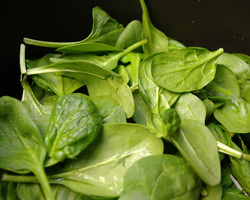 Courtesy Stock.XCHNG The Food Modernization Act was prompted by the nation’s food recalls to basic kitchen staples, like spinach. |
The workings on Capitol Hill may feel worlds away from farm life, but the Food Safety Modernization Act (S.B. 510), scheduled for debate today in the Senate, brings legislative issues to our front porch. A complex and controversial bill,
S.B. 510 warrants scrutiny and involvement, especially from the small, family farm community.
Let’s start with the core ingredients behind the Food Safety Modernization Act that everyone, in theory, agrees on: the fundamental right of all Americans to eat safe food and the need for improving checkpoints to achieve this.
While the concept seems simple and fundamental, when you start formulating the “how” behind ensuring such rights, complexity and controversy overflow. Over the past century, we evolved from a nation of farmers to an industrialized food system intricate in layers and players. As Americans, we leaped from a country where the majority of us regularly ate what’s now known as the “100-mile diet” to one where we can’t pronounce names on a soup can’s ingredient list, much less know where they came from.
The Act’s History
The current corporate agricultural system inherently increases risk in the food supply, and in many ways, the Food Safety Modernization Act is playing catch-up. It aims to regulate and control the nation’s food supply and the industrial-rooted problems created over the past 100 years.
Prompted by public outcry on recalls of basic kitchen staples like eggs, spinach and peanut butter, Senator Dick Durbin (D-Ill.) first introduced the bill in March 2009. The core legislation goal is to increase the power of the Food and Drug Administration to better monitor and prevent food-borne disease outbreaks, increasing the ability of the FDA to trace problems back to the source and holding those parties responsible.
While such general intents may sound reasonable, S.B. 510 has the potential to aversely affect small farms because of a “one size fits all” legislative approach. By forcing growers of all sizes and locations to adhere to the same regulations, small operations won’t be able to afford the associated costs, paperwork and time commitment.
Amendments Support Small Farms
“While the Food Safety Modernization Act takes important steps to improve corporate food safety rules, it is not appropriate for small farms and processors that sell to places like restaurants, food co-ops, farm stands and farmers’ markets,” explains Annette Higby, grassroots coordinator for the National Sustainable Agriculture Coalition, an advocacy group representing more than 80 sustainable-agriculture groups across the country. “As we ramp up food-safety protections, it’s critical that we don’t inadvertently do harm by imposing expensive, ‘one size fits all’ rules.”
To address these concerns, small farm and sustainable-agriculture advocacy organizations like NSAC are championing two amendments that will be offered when S.B. 510 hits the Senate floor:
- The Tester-Hagan Amendment creates size-appropriate requirements and less costly compliance alternatives. For example, farms that direct-market more than 50 percent of their product to customers through on-farm or retail outlets, such as farmers’ markets, would not need to register with the FDA.
- The Manager’s Amendment adds in multiple recommended changes that have arisen since the bill was first introduced to reduce paperwork and regulations for small farms and operations.
“Farmers need to remember that it is important that we share our stories and experiences with our elected officials and that we play an important role in the legislation process if we make our voices heard,” explains Gini Knight, a Wisconsin-based farmer who just finished the first growing season of her operation, Sweet Magnolia Farm. “Unfortunately, there are increasing barriers for small scale farmers and we must keep ourselves informed and engaged when legislation like the Food Safety Modernization Act comes up in order to preserve our nation’s family farms.”












